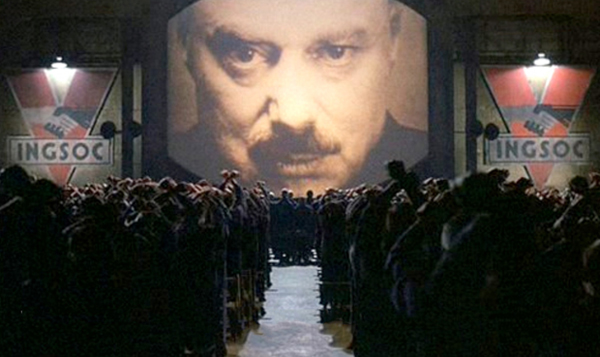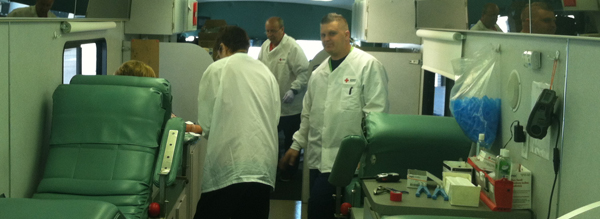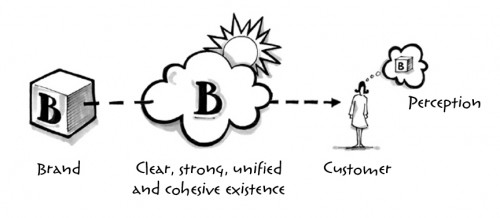
I recently came across an interesting piece on the Harvard Business Review that essentially deals with our own discomfort with the issue of race and how this discomfort can actually impede open and honest discourse in the workplace. If you have time, grab a friend and go through the short exercise here. I did this with a coworker and it ultimately lead to an interesting discussion about race, preconceptions and how we create unnecessary barricades in communication. In a broader sense, this is about how we fear being perceived.
This basic study got me thinking about the way we impede productivity by overcomplicating the way in which we communicate internally. I worked for an employer who believed that only 30% of e-mail sent was actually read and understood by the recipient, a percentage that goes down from there when you add multiple recipients. He believed that as soon as soon as confusion reared its head in such correspondence, a phone needed to be picked up or someone needed to walk over to a desk for clarification. I have also seen the way the same message could be interpreted differently by individuals in an organization based on their own filters and motivations. I found this study interesting, especially given the current heightened discourse on the extent to which race factors into our thinking. The lesson in this study I think, and I would be very interested in your opinion, is that often our own fear of touching on a perceived taboo hinders our ability to bring all of the pertinent elements into the conversation. The kids who did this game that were under nine years old performed better than adults. They don’t carry the baggage into this game that we do.
This writer is always intrigued by technology that facilitates communication, makes it faster and easier to talk, share and move initiatives forward. However, is still on human beings to ensure that the quality and substance of this communication does justice to the manner in which it is delivered and acted upon.

In light of the recent Edward Snowden – NSA information tracking kerfuffle, I found Stephen Clifford and Quentin Hardy’s article in Sunday’s New York Times particularly interesting. The piece brings us up to speed on the extent to which brick and mortar retailers can now use your cell phone’s WIFI signal to track your shopping habits in order to build more targeted, personal marketing campaigns. So far, this concept has been met with disdain and concern from consumers. It would seem that the same kind of “anonymous” tracking that takes place on your browser searches and used for advertising purposes gets a pass in public opinion, while the physical tracking of in-store behaviors is viewed as more intrusive and personal Consumers may have a point.
Based on the cell phone on your person, an increasing number of retailers like Nordstrom can track the frequency and length of your store visits. They monitor your location in the store and the amount of time spent perusing the aisles and viewing certain store displays. Realeyes in London has software that can analyze facial queues from on-line ads to determine your emotional reaction. The technology also exists to marry personal information on your phone from app downloads, such as e-mail and cell phone numbers for the purpose of running specialized coupons. This is not a completely new concept. Check out this piece from the Harvard Business Review which has done a great job following this phenomenon for the last 3 years. You can count on companies looking to master this technology to deliver the most impactful, personalized advertising efforts to maximize sales. As always, a good barometer for business trends would be the Apple Index… In March Apple acquired a company called WiFiSLAM for a cool $20 million, the equivalent of belly-button lint in Apple’s world but a major win for the small company who developed GPS software that triangulates consumer location, tracks every move they make and delivers a marketing message specifically tailored for that customer. In my case, I’d get a text telling me that the 16 year Lagavulin single malt was on sale in aisle 3.
This brings us back to an important question. Are we copasetic with the idea that we live in an age where the price of technological advance (on an existential scale, our safety) is our privacy? Will there be a market for privacy protection? Will we simply replace blanket advertising with more personalized efforts? I might be OK giving up mailers, calls and e-mail blasts from companies tragically misguided on the likelihood of my purchase. I might be a little more self-conscious about the frequency and length of time I spend in the candy aisle (why is a 38 year old man puzzling over the Sour Patch Kids)? I do worry though that this information will lead to an increase in retail noise. It also has me worried about the extent to which I am attached to my phone. As I thought about beating the system by leaving my phone at home, I felt panic and separation anxiety. I’d sooner leave my wallet at home than my phone. Maybe this is the bigger concern.

Last Friday over half of the Volano team volunteered to donate a pint of blood to the American Red Cross. Our team stepped it up and even brought donuts and bagels in a preventative pass-out strike. (There’s always that one guy). I’m happy to report we suffered no casualties. I’m also happy to report that our dart and cocktail schedule was not interrupted. Hydration is for suckers.
When talking with one of the Red Cross employees, I was struck by the shortage and need for blood. Conventional wisdom would dictate that exposure to our now constant news cycle might create a greater awareness and imperative for donating blood. So I hopped on their website and also looked at recent stories on blood shortages over the last few years. Not surprising, natural disasters deplete reserve supply. Hurricane Sandy caused the cancellation of key blood drives due to power outages and perilous weather conditions. So you have a double negative going on, a spike in demand in areas where blood drives are prohibited from taking place due to the very disaster that created the need. The Boston bombings have now become noteworthy for the relatively low casualties, largely due to the top-notch medical facilities and first responders. Much donated blood was used to save lives that day.

The Red Cross employee I talked to said locally the donor blood supply was down about 20% from their goal. Before I got too swept up in outrage, I realized there was a solid decade plus in between my donations. I’m pretty sure I threw out my donor card along with my Blockbuster Video rental card.
So here are a just a few reasons to consider penciling in blood donation.
- Every two seconds a patient in the U.S. is in need of blood
- One of every seven people checking into a hospital is in need of a blood transfusion
- Only 3% of the U.S. population donates blood – you’d be in an elite club
- Recipients of donated blood are among some of the most vulnerable – premature babies, children being treated for heart problems and cancer and trauma patients to name a few
- Donating takes about 10 minutes
So, Volano didn’t save the world Friday, but we joined an elite club and paid it forward a little. If you’re interested in doing the same, check out The Red Cross website and schedule a donation when you have a few spare minutes.

This week I joined the Volano Solutions Team. My goal is to ruthlessly climb to the top and achieve world domination, one client engagement at a time. So you should know a little bit about me.
I was born and raised here in Omaha and got my first taste of computer programming in high school. My freshman year I joined the high school chess club. The teacher that headed the chess club turned out to be the computer programming instructor so the following year I enrolled in his class and started writing QBASIC. By the end of high school, I had exposure to Visual Basic and C++ as well and I also caught the software bug.
Fast forward to college or at least round one of college. After graduating I enrolled at Iowa State University majoring in Computer Science. After two years of Computer Science curriculum, I decided I was going to go to Medical School and changed my major to Biology. During my time as a biology major I became a certified nursing assistant and began working at the local hospital in the oncology unit. Despite my best efforts to excel in my new major, I did not have the same passion for Biology that had for Computer Science and ended up leaving Iowa State and moving back to Omaha after three years.
After returning to Omaha, I spent the next few years working various jobs including house painter, pizza delivery guy, and various other odd jobs including waiting tables. After a few years at the same restaurant I decided it was time to give school another try.
I enrolled at University of Nebraska at Omaha once again studying computer science. I was astonished at how fast I picked up programming after so many years away. Over the next three years I went to class during the day and worked at the restaurant in the evenings. I started studying at night and would often be up until five or six in the morning working on projects. My final year of school I got the opportunity to work for UNO as a tutor. After graduation I took a job doing web development for a local actuarial consulting firm getting my chops and am excited about the next phase of my young career at Volano.
Much has been written about the importance of building, maintaining and protecting your brand. Providing a consistently good product and equally important, a consistently exceptional customer buying experience are cornerstones of any business. This idea is especially critical for growing franchise companies. I have a lot of experience marketing, selling and managing franchise sales. I used to work for a highly successful California-based franchisor and saw first-hand how quickly sales could be compromised at a particular location when owners deviated from the established brand model, whether it was by purchasing product outside of approved vendors, not using systems provided by corporate or failing to utilize effective, branded marketing collateral. This was always a struggle as many owners purchased the business to get away from the constraints of a previous job and were not as interested in applying the model. Today, there are greater opportunities to promote and market your business. Social media is one area that can help local owners capitalize on a national brand but it can also be an area where owners go “rogue” and convolute the message. The following piece discusses the peril of websites that are inconsistent with corporate brand standards. http://empowerkit.com/blog/marketing/achieve-brand-compliance/.

When franchise companies have an established brand, capitalizing on that is an imperative for business owners who have bought into the model. It is then the responsibility of the corporate office to ensure that their owners are in compliance with these standards and equally important in protecting the brand from infringement. http://www.franchoice.com/resources/franchise-articles/Protecting_Your_Brand. Strong brands are directly related to consumer purchasing. Large, non-franchise companies with thousands of locations have an advantage in maintaining brand standards since store managers’ employment is largely dependent on the extent to which their locations maintain pricing, signage, customer service, hours and best practices that line up well with the defined standards. This is why your experience in Starbucks is so consistent. Appropriately, their hiring practice and the simple mantra that is sewn on the inside of the barista apron (Anticipate. Connect. Personalize. Own.) ensure a highly consistent level of service. I always want to support the little guy but have no patience for bad service. A bad hire and a confusing process makes cost irrelevant. We pay for the experience. To that point, John DeJulius gets it right. http://blog.thedijuliusgroup.com/2012/07/05/ and has the chops to show for it.
So what does software have to do with maintaining brand standards for franchisors? Volano Solutions is currently working on a mobile application for regional franchise managers. This tool will replace the current, paper-intensive method currently standard in growing franchise companies and will allow for faster collection of data from on-site visits and greater visibility for the corrective actions between the franchisee and corporate. The idea is to position this franchise support rep to spend more time helping develop their owners and less time auditing them. It also ensures that the information collected will drop into a transparent, accountable workflow for reconciliation. In that respect, technology can be a conduit to greater adherence to franchise brand standards. It also saves time. We’re excited to roll this out and have early, local interest in beta-testing the application.
Does your business struggle with brand consistency?
This morning I read a blog by NY Times contributor David Pogue on innovative products that solve small problems . If you have time, check it out. There are a few cool products that might raise your eyebrows.

Pogue’s piece made me think of the controversial and widely panned talk that the Silicon Valley angel investor Dave McClure gave this year at Big Omaha. McClure’s larger idea on focusing on small ideas that solved problems was lost on his unfortunate and vitriolic delivery. However, he did make a good point. McClure encouraged entrepreneurs to look at solving small problems. His philosophy is that we’ve accepted mediocrity as a new standard and ample opportunity existed in the marketplace for innovation by simply making some lackluster product or process better. My favorite example was airplane food.
Of the products discussed in Pogues blog, I really like the “Charge Card,” a much more portable charging solution for your mobile devices that fits in a wallet and does not require a cable. For me this product saves a couple of steps. I currently use a portable charging battery that is too bulky to carry in a pocket and requires frequent charging from an outlet prior to use. At $25, the Charge Card is a great value and comes with a lifetime guarantee. It’s not sexy but I see universal appeal here in this little wallet sized savior of the dying phone battery. I cannot risk the possibility of running out of juice prior to hitting the 150 picture quota of my bemused children playing outside. My facebook friends who pine for said pictures would be remiss.
Volano Solutions is working with another problem-solving innovator, Hunt Force. Hunt Force is a Louisville KY based software developer creating an application that will more easily manage the motion-detector photos used by hunters and taken by trail cameras. In a previous blog I mentioned that we were partnering up with start-up accelerator Straight Shot to help companies whose ideas helped solved problems. Hunt Force is a great example of a company that decided to make life a little easier for a group of people that had a common problem. The time hunters and property managers currently spend transferring data from these trail cameras and physically having to save and delete images took away from their time actually hunting.
So if you have time, check out the MagSafe product featured in David Pogue’s blog. McClure was right… That $20 glorified plastic clothespin might be the best spend in your IT budget this year. It doesn’t save the world but it solves a headache to which Mac users can attest.